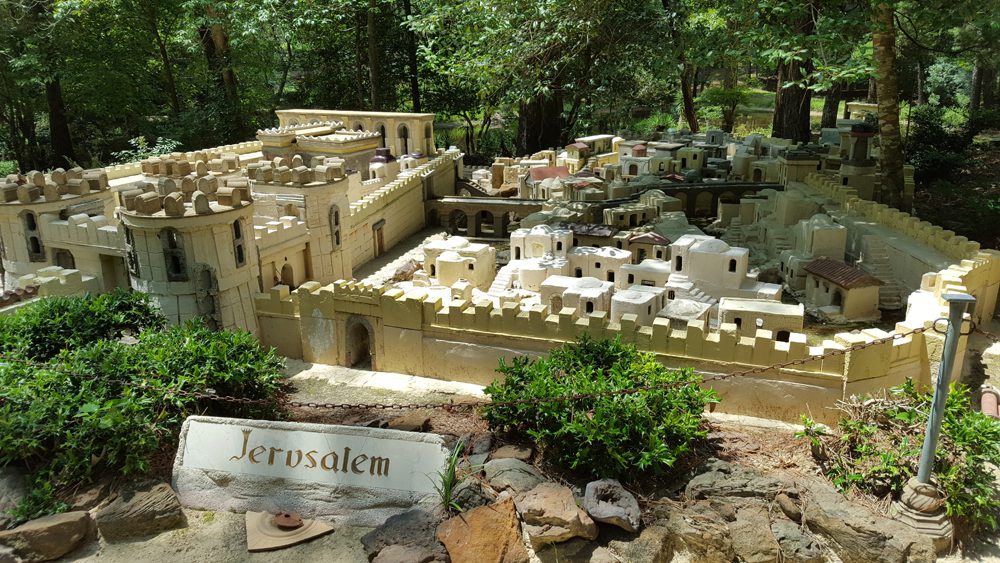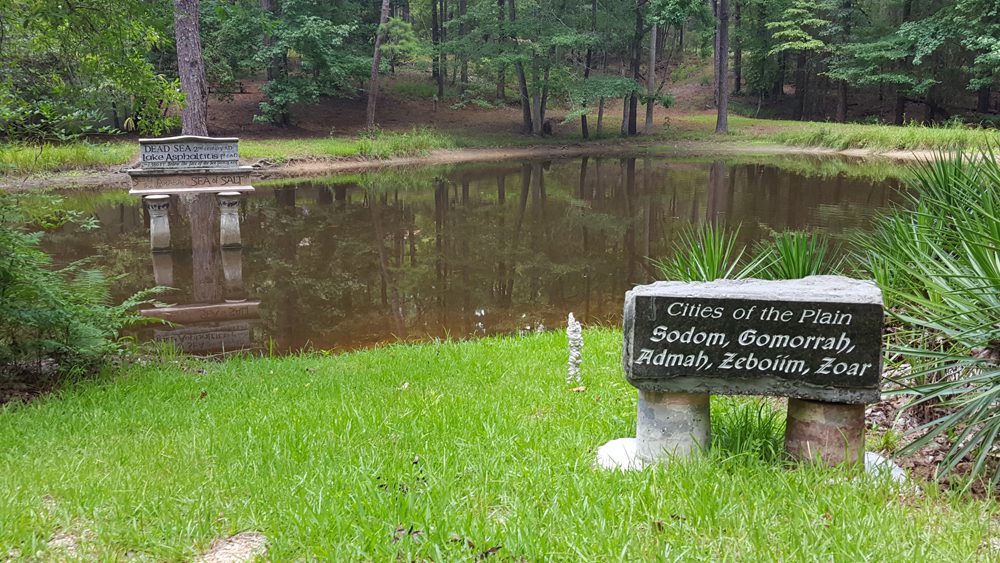Holy Lands: Palestine Gardens in Mississippi
Benjamin Morris drives to Lucedale, Mississippi, where a scaled replica of the Holy Lands exists as a Christian pilgrimage site.

A scaled replica of Biblical Jerusalem at Palestine Gardens in Lucedale, Mississippi. Photo by the author.
Few places are more interesting to visit than the past. In the 60 years since writer L.P. Hartley observed, “The past is a foreign country: they do things differently there,” archaeological and historical tourism seems to have become one of the most magnetic sectors of the tourism economy. Ever more sites are being discovered, or in some cases, replicated, or even fabricated, drawing would-be tourists to new destinations. Prominent among those are museums of Biblical history—Creationist theme parks usually intended to advance the Young Earth interpretation of creation, which argues dinosaur fossils should live alongside models of Noah’s Ark. There are now over a dozen in the United States alone.
The imaginative prospects of such time travel are endless. Unsurprisingly, however, such parks garner equal parts admiration and ridicule, and in many cases rely on this tension to drive visitors through their doors. Yet even as these sites allow the furor of controversy to fuel continued interest in their very existence, other, nuanced approaches to Biblical narratives can still be found. Within a day’s drive from New Orleans is one such destination, a site that is at once careful, thoughtful, and even beautiful: Palestine Gardens in Lucedale, Mississippi.
Begun in 1960 by Reverend Walter Harvell Jackson, a Presbyterian minister, Palestine Gardens is situated on 40 acres of gently rolling pine forest deep in southern Mississippi’s lowland hills. A scaled replica of the Holy Land during and before the time of Christ, the Gardens predate recent trends to bring Biblical geographies to life through more theatrical means. Nestled within the pines, ancient cities rise out of concrete, cinder blocks, and clay, and rivers emerge from hand-cut gullies and ditches. Shallow ponds become expansive seas, and low-lying rises, the mountains Ararat and Hebron. Each of the major provinces (Judea, Galilee, and Samaria) contain their key cities, with place names helpfully categorized both by Old and New Testament references.
Herod’s Temple in Jerusalem dominates the tiny skyline, and the Dead Sea, even here, harbors an eerie stillness. Yet it would be easy to miss the small touches of detail that enliven the Gardens’ locales, such as the tiny amphorae of wine at Cana representing one of Jesus’ first public miracles. Indeed, touches of humor can be found scattered throughout, and they feel like the rewards of a treasure hunt. In contrast to its New Testament counterpart nearby, the Old Testament city of Jericho is represented only by a pile of rubble (thanks to Joshua), and elsewhere, near Sodom and Gomorrah, one finds a tiny pillar of salt to represent a certain stubborn spouse. Even the fig tree that Zacchaeus climbed in order to see Jesus more clearly makes its appearance, but in this case, as a sapling no larger than a sprout.

A site representing the Dead Sea and the Cities of the Plain at Palestine Gardens in Lucedale, Mississippi. Photo by the author.
Such whimsy is a welcome element of the Gardens, and, alongside its creative use of humble, local materials, situates it firmly within the tradition of lighthearted folk art unafraid to poke fun at itself—leavening its seriousness. Granted, to enter a site like this and not expect evangelism is like entering a restaurant and not expecting dinner—but caretakers of the site since Jackson’s day have long known that there is more to proselytization than pulpit-pounding or telethons. Rather, their approach involves a combination of personal testimony—Don Bradley, owner of the site and guide since 1991, shares his faith in the most gentle and respectful of manners—and, interestingly, imagination. As the cities in the Gardens are deliberately devoid of people (for the most part, only a few Roman toy soldiers stand guard), seeing the bare architectural design alone invites the visitor to imagine themselves within those streets, down in the shadow of the colonnades, or lounging atop the flat, sun-baked roofs of Jerusalemite homes. From there, it is but a short step to wonder what we would have made of our friends and neighbors two millennia ago, excitedly debating a man allegedly performing miracles, a man in our own backyard claiming to be God.
All monuments to the past must routinely entertain questions about their future, and Palestine Gardens is no exception. Having been exposed to the elements for decades, many of Jackson’s original models have been lost, as the materials of plaster, concrete, and cinder blocks weather and degrade. Unfortunately, only modest portions survive today: the villages of Bethlehem and Nazareth and sections of the temple colonnade in Jerusalem, among a few others. In the New Testament site of Jericho, only one original building remains. Over the years, subsequent caretakers—Jackson died in 1992—have sought to repair and stabilize his work, including a major restoration project that began in 2008.
Yet attempts to preserve the site from further decay are only part of the story of the site. Bradley notes that growth and development are key to the Gardens’ long-term survival: While preserving Jackson’s original aesthetic and materials, he also envisions a series of needed expansions, such as widening the walking path, adding an exhibit on the journeys of the Apostle Paul, and finally bringing water to the Jordan River, a major feature of the site which remains unfortunately dry. He has even updated the site to reflect recent archaeological discoveries, such as the Pool of Siloam that was unearthed in Jerusalem in 2004. In this view, Bradley considers his work a natural extension of Jackson’s, a theological, historical, and creative partnership that is more collaboration than conservation.
With widespread interest in the site, the Gardens seem in little danger of disappearing. Today, Bradley says, visitors arrive not just from the Gulf South, but from all over the world—from places as remote as Israel, Bolivia, and Libya in the past few months alone—and even relying solely on donations, the site has remained almost entirely self-sustaining. What draws these visitors in—curiosity, chance, or a desire to explore Christian beliefs outside of a church—is impossible to say, but one thing remains true. To see such a humble object as a cinder block, hewn and arranged just so, become a tiny residence, or to witness a pattern of cracked tile yield an ancient agora, remains a remarkable experience, and a testament to the vision of the architects of the site. In this respect, the Gardens is best understood as a longtime labor of love—like, writ large, the very book that it depicts.
Editor's Note
Palestine Gardens is located in Lucedale, Mississippi, about a two-hour drive from New Orleans, and is open Tuesday through Sunday. We recommend contacting Palestine Gardens before visiting to ensure the site is open.



